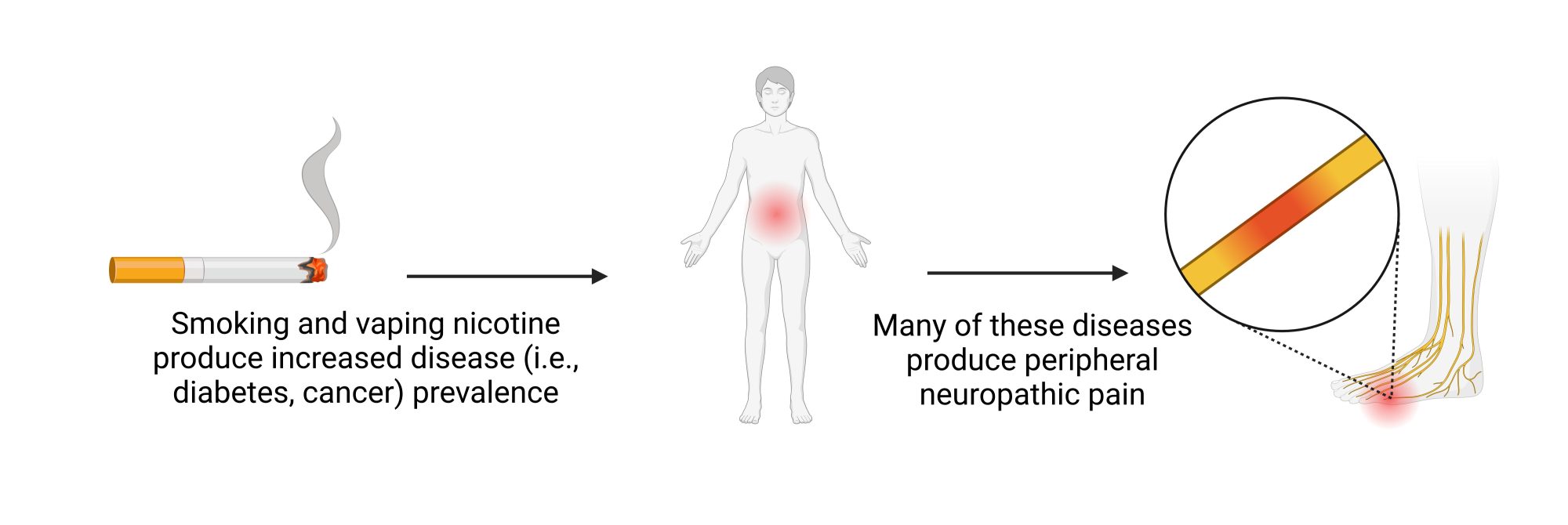Lance R. McMahon, Ph.D. and Jenny L. Wilkerson, Ph.D. from Texas Tech University Health Sciences Center, describe the search for the magic bullet to treat both neuropathic pain and nicotine dependence using novel epibatidine derivatives as potential therapeutics
Nicotinic acetylcholine receptors (nAChR), specifically nAChR containing α4β2* subunits (* denotes additional receptor subunits), are known for their role in nicotine dependence and addiction (1). These receptors are found throughout the central and peripheral nervous systems on neuronal, glial, and immune cells (2). Although varenicline, an α4β2 nAChR* partial agonist, is a useful smoking cessation pharmacotherapy, the largest individual cause of preventable death continues to be cigarette smoking. (1)
Nicotine dependence and chronic neuropathic pain
Up to 17% of the global population live with neuropathic pain, which is produced from injury to the nervous system and is associated with significant impairment in quality of life. (2,3) Conditions producing neuropathic pain are increasingly prevalent in tobacco-dependent individuals, e.g., lung and other cancers, which, when treated with chemotherapy, often result in peripheral neuropathy, as well as peripheral neuropathies in diabetic patients (Figure 1). (3)
Neuropathic pain is poorly controlled by current pharmacotherapeutics, which include tricyclic antidepressants, serotonin and noradrenaline reuptake inhibitors, antiepileptic drugs, and opioids, all of which have significant side effect profiles (3). A compound that can successfully treat both chronic neuropathic pain and nicotine dependence would be extraordinary.

α4β2* nAChR agonists as pain therapeutics
Many nAChR agonists, including those acting on α4β2* and α7 nAChR, have pain-alleviating effects in preclinical studies (3); however, the potential for α4β2* nAChR agonists to be viable pain medications has yet to be realized. Epibatidine, one such α4β2 nAChR agonist, initially garnered interest for both its analgesic and anti-nicotine dependence effects, yet a low therapeutic index due to toxicities has limited its development as a safe therapeutic (3).
Medicinal chemistry of novel epibatidine derivatives
Epibatidine (chemical name (±)-exo-2-(6- Chloro-3-pyridinyl)-7-azabicyclo[2.2.1.] heptane) has become an important chemical scaffold used by several independent laboratories to further investigate α4β2* nAChR pharmacological activity. Dr. F. Ivy Carroll, Distinguished Fellow for Medicinal Chemistry and Lead Medicinal Chemist at Research Triangle Institute (RTI) International’s Center for Drug Discovery, spearheaded such a campaign, which led to the synthesis of numerous novel epibatidine derivatives that act as α4β2* nAChR agonists and antagonists. Previous studies have described the synthesis, nAChR binding affinity, and pharmacological properties of numerous novel epibatidine analogues produced by Dr. Caroll and his laboratory. (4,5)
Exploration of novel epibatidine derivatives for nicotine dependence and neuropathic pain
Approved nicotine dependence medications like varenicline share similar but not identical pharmacological activity to the targeted abused drug nicotine. (3) To determine whether a novel compound shares pharmacological properties with nicotine, behavioral assays, referred to as nicotine discrimination assays, have proven useful in developing pharmacotherapies for nicotine dependence. A compound that shares effects with nicotine in this assay is likely to include α4β2* nAChR as a major part of the mechanism of action.
Three epibatidine derivatives, 2’-fluoro- 3’-(4-nitrophenyl) deschloroepibatidine (RTI-7527-102; i.e., RTI-102), 2’-fluorodeschloroepibatidine (RTI-7527-36; i.e., RTI-36), and 3’-(3′′-dimethylaminophenyl)-epibatidine (RTI-7527-76; i.e., RTI-76) were tested in both the rat nicotine drug discrimination assay as well as in the rat chronic constriction injury (CCI) of the sciatic nerve neuropathic pain model. (3) In the nicotine discrimination assay, the rank order potency (i.e., the amount of drug required to produce a specified amount of effect, usually half the full effect) was RTI-36 > nicotine > RTI-102 > RTI-76.
In a separate cohort, Sprague-Dawley rats underwent nerve ligation surgery and tested for light touch sensitivity, termed mechanical allodynia, which is a surrogate for peripheral neuropathy. RTI-36, RTI-102, and RTI-76 reduced the mechanical allodynia at doses that did not produce unwanted effects. (3) Each compound produced mechanical allodynia reversal at doses that fully substituted for nicotine, which suggests that at therapeutically active doses, these compounds produce a subjective experience similar to that produced by nicotine. (3)
Conclusions and future perspectives of α4β2* nAChR-targeted therapeutics
Although epibatidine is not an ideal clinical candidate, its α4β2* nAChR agonist derivatives described here may be useful analgesics if they display analgesic-like effects at doses that do not produce toxicity or other side effects. As nicotine is highly addictive, the abuse and dependence potential of these compounds should be further explored before these derivatives are considered as viable potential novel analgesics. Additional work on the receptor selectivity and binding activity of these and related analogues may yield better therapeutic leads. However, α4β2* nAChR agonists could serve the dual purpose of a smoking cessation aid and analgesic.
References
- Moerke MJ, McMahon LR, Wilkerson JL. More than Smoke and Patches: The Quest for Pharmacotherapies to Treat Tobacco Use Disorder. Pharmacol Rev. 2020;72(2):527-557. doi:https://doi.org/10.1124/pr.119.018028
- Wilkerson JL, Deba F, Crowley ML, Hamouda AK, McMahon LR. Advances in the In vitro and In vivo pharmacology of Alpha4beta2 nicotinic receptor positive allosteric modulators. Neuropharmacology. 2020;168:108008. doi:https://doi.org/10.1016/j.neuropharm.2020.108008
- Luque-Sanchez, K., Felix, J., Bilbrey, J., Restrepo, L., Reeves, M., McMahon, L. R., & Wilkerson, J. L. (2023). Evaluation of novel epibatidine analogs in the rat nicotine drug discrimination assay and in the rat chronic constriction injury neuropathic pain model. Advances in drug and alcohol research, 3, 11622. https://doi.org/10.3389/adar.2023.11622
- Carroll FI, Ware R, Brieaddy LE, Navarro HA, Damaj MI, Martin BR. Synthesis, nicotinic acetylcholine receptor binding, and antinociceptive properties of 2’-fluoro-3’- (substituted phenyl)deschloroepibatidine analogues. Novel nicotinic antagonist. J Med Chem. 2004;47(18):4588-4594. doi:https://doi.org/10.1021/jm040078g
- Carroll FI, Ma W, Deng L, Navarro HA, Damaj MI, Martin BR. Synthesis, nicotinic acetylcholine receptor binding, and antinociceptive properties of 3’-(substituted phenyl)epibatidine analogues. Nicotinic partial agonists. J Nat Prod. 2010;73(3):306-312. doi:https://doi.org/10.1021/np9006124

This work is licensed under Creative Commons Attribution-NonCommercial-NoDerivatives 4.0 International.


